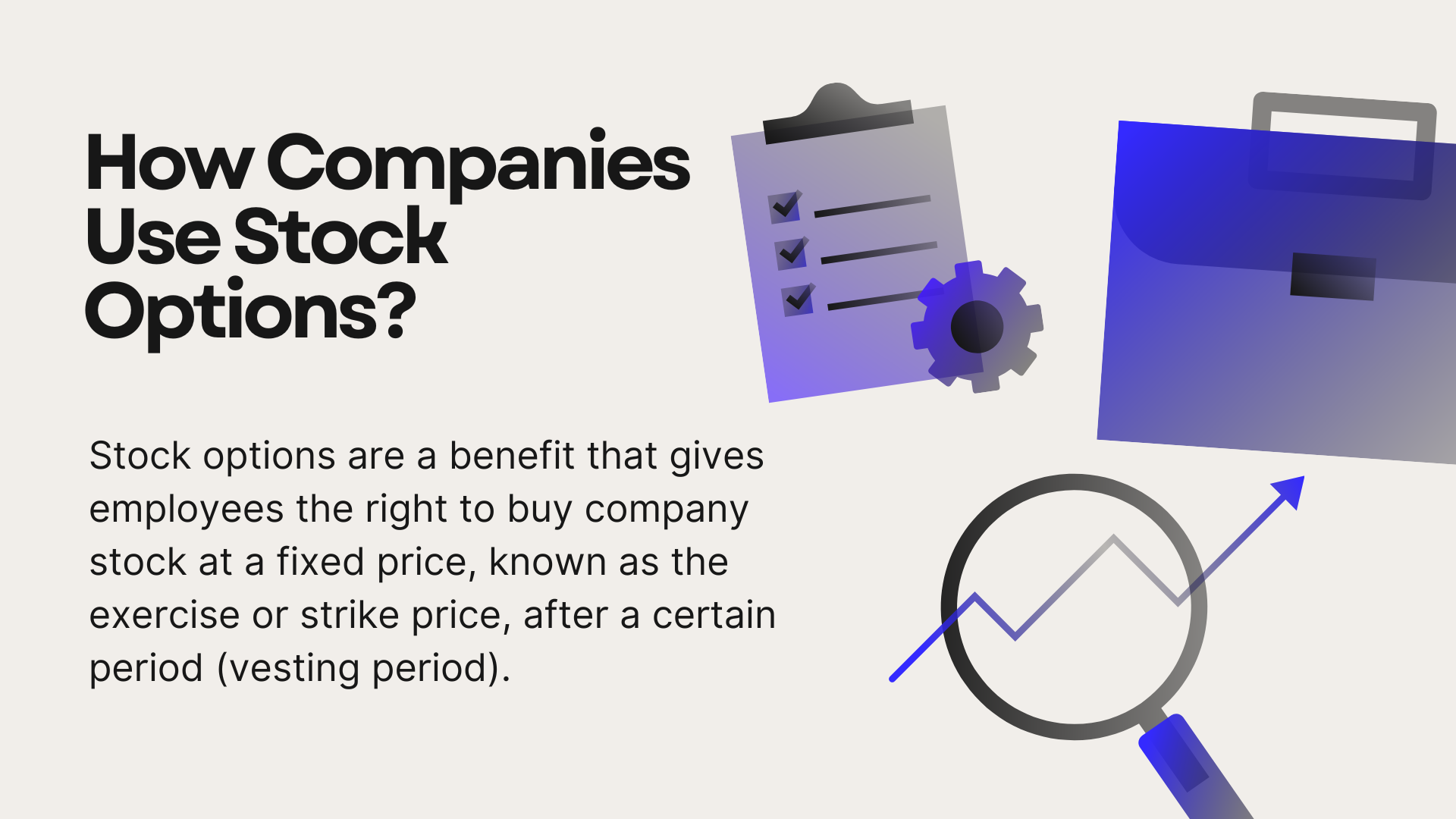
How to Avoid the Most Common 401(k) Rollover Mistakes?
Just switched jobs? What you do with your 401(k) next could either save or drain thousands from your retirement.

In today’s competitive job market, employee stock options have emerged as a strategy that connects employee success directly with the company’s growth.
But what exactly are stock options for employees?
While many professionals are familiar with employee stock purchase plans, stock options offer a different yet equally powerful opportunity.
A stock option, also known as an equity option, gives an employee the right—but not the obligation—to buy or sell a stock at an agreed-upon price and date.
This article answers in depth what stock options are for employees and how they can be a valuable part of a compensation package.
A stock option is an equity incentive that employees can receive in addition to their regular salary and other compensation.
Beyond being just an alternative incentive, what are stock options for employees?
Simply put, for employees, they are the possibility of a big future payday.
Stock options are a benefit that gives employees the right to buy company stock at a fixed price, known as the exercise or strike price, after a certain period (vesting period).
In theory, the better an employee performs, the more the company’s value and stock will rise, thereby increasing the potential profit employees earn if and when they decide to sell their shares.
It’s a win-win scenario.
Traditionally, stock options have been a valuable way to attract top talent, encourage “key” employees to stay with the company, and reward top management for their hard work to help make the company successful.
However, companies are increasingly starting to view every employee as a “key” one and are offering this benefit to entry-level employees, too.
Companies often grant stock options when an employee first joins, with additional grants given annually or as bonuses.
For instance, JPMorgan CEO Jamie Dimon was awarded 1.5 million stock options that vest over five years to encourage him to stay with the company.
For growth-oriented companies, particularly startups, stock options are a flexible way to motivate employees when they can’t meet top talent’s salary expectations.
With stock options, a small company can conserve cash while allowing employees to benefit from future successes.
Similarly, they make sense for public companies with already established benefit plans that want to give employees an ownership stake.

You might be wondering, how do stock options work for employees?
Stock options are not the same as owning stock outright—they just allow employees to buy a specific number of company shares at a predetermined price. This is often called a grant, strike, or exercise price.
Since the grant price remains fixed, any increase in the stock’s value could lead to a profit when the employee eventually sells the shares. The goal is to sell the shares higher than what they paid.
However, it is important to note that purchasing stock options for employees is, as the name suggests, an option and not an obligation.
The lifecycle of employee stock options typically unfolds in four key stages: grant, vesting, exercise, and sale.
The first thing to know is that any contract for employee stock options will list a grant date. The grant date is the official date when the stock options are provided to the employee so that you can think of it as the start of the lifecycle.
This date is important because it locks in the strike price of the company’s current valuation, which remains fixed regardless of how the company’s stock price fluctuates in the future.
Next, the contract will also state how many shares the employee can purchase under the option.
Here is an example with Startup X:
If an employee joins Startup X, they might receive 1,000 stock options at a strike price of $100. This means the employee can buy 1,000 shares at $100 each, even if the price goes up in the future.
How does the share price increase? As the startup grows, it raises more money from investors at higher valuations. As a result, this increases the value of each share.
After 4 Years:
Now, the employee can buy 1,000 shares at $100 each and sell them for $400 each.
Wealth Calculation:
When a company offers employee stock options, they aren’t given all at once.
Instead, they are earned over time through a process called vesting. Vesting encourages employees to stay with the company for a longer period.
For example, if a startup grants 1,000 stock options when an employee joins, the employee can’t take all the options after just a short time, such as one month.
Instead, with vesting, the employee is required to work for the company over a set period to earn the stock options gradually, hence why stock grants are often called a “golden handcuff.”
Generally, vesting follows a linear schedule, but some options also vest based on meeting specific company or team performance goals.
In the USA, a common practice is a seven or 10-year equal vesting schedule, though shorter periods are also common.
Here’s an example of what a 4-year vesting schedule might look like:
Total Stock Options: 1,000
Employees who leave the company between years 1 and 2 will only get 25% (250 options) of the original 1,000 stock options. If they leave after the second year, they will receive 50% (500 options).
To receive all 1,000 stock options, the employee must stay with the company for four years.
So, what is the next stage after vesting?
After the vesting period ends, the employee fully owns all the stock options that were granted.
In other words, they have the right to “exercise” these options at any time, according to the terms of the stock option plan.
Once fully vested, the employee can choose to:
It’s important to note that some stock option plans have an expiration date, typically ten years from the grant date, after which any unexercised options are forfeited.
Therefore, after the vesting period, the employee must decide when to exercise their options based on their financial goals and market conditions.
Now that we’ve answered the question of what are stock options for employees, you might be curious—what makes them such a powerful benefit for employees?
Stock options transform employees into partial owners, directly tying their financial interests with the company’s performance.
For many, this unique blend of ownership and reward transforms their role into more than just a job—it becomes an investment in their future.
Moreover, stock options provide employees with a sense of security and long-term financial planning, similar to how one might approach a projected 401(k) value.
Unlike traditional incentives like cash bonuses, which offer immediate but limited rewards, stock options can create lasting wealth, especially when the company excels.
For these reasons, many employees find that the potential of stock options can make an employment offer more attractive, even if the base salary is less than expected.
One of the major disadvantages of stock options for employees is that many workers may not have the knowledge to exercise a stock option or follow investment management trends.
In fact, research shows that over half of entry-level employees chose not to exercise any of their profitable stock options.
Junior employees often lack experience with stock options and might benefit from additional education on equity to build the confidence needed for making informed decisions about their shares.
For these reasons, companies should consider offering financial coaching as an employee benefit so employees can gain knowledge, such as the tax implications of an exercise, and learn how to manage their money better.
There are two main types of stock option programs, each with its own set of rules and tax implications: non-qualified stock options (NSOs) and incentive stock options (ISOs).
The term “non-qualified” means these options don’t qualify for special tax treatment from the IRS. With NQSOs, investors must pay taxes when they exercise the options and when they sell the shares.
On the other hand, ISOs are only available to employees, and the value of ISOs that can vest in any calendar year is limited to $100,000.
In this case, employees won’t have to pay taxes when they exercise the options, but they might need to pay the alternative minimum tax (AMT) if they hold onto the shares for too long without selling them.
Answering the question of what are stock options for employees is important for both employers and employees, as these options can significantly shape long-term financial strategies.
These options present a unique chance to build wealth, giving employees a direct stake in the company’s growth and the potential to earn significant financial gains over time.
When making decisions about stock options, it is recommended that you consult with a financial advisor or tax professional to maximize the benefits and avoid potential pitfalls.
Senior Content Writer at Shortlister
Browse our curated list of vendors to find the best solution for your needs.
Subscribe to our newsletter for the latest trends, expert tips, and workplace insights!

Just switched jobs? What you do with your 401(k) next could either save or drain thousands from your retirement.

How can employers create and implement a successful financial wellness program? And what does success mean?

Understanding how interest earnings accumulate in a deferred annuity is crucial for making informed decisions about retirement planning. Explore the concept of deferred annuities, how interest earnings accumulate in deferred annuities, and the types of deferred annuities available in the market.

Could stock options be the decision that transforms your career into a life-changing investment opportunity?
Used by most of the top employee benefits consultants in the US, Shortlister is where you can find, research and select HR and benefits vendors for your clients.
Shortlister helps you reach your ideal prospects. Claim your free account to control your message and receive employer, consultant and health plan leads.